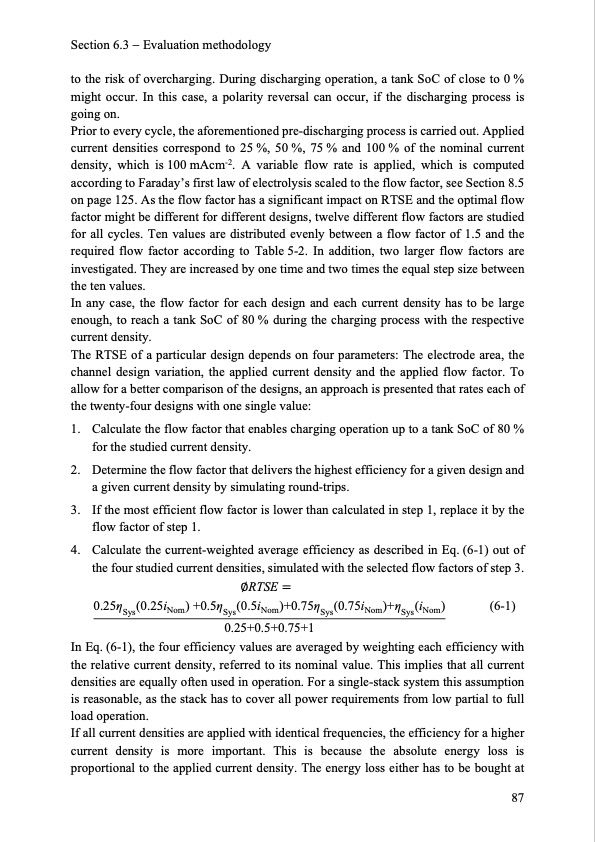
PDF Publication Title:
Text from PDF Page: 095
Section 6.3 Evaluation methodology to the risk of overcharging. During discharging operation, a tank SoC of close to 0 % might occur. In this case, a polarity reversal can occur, if the discharging process is going on. Prior to every cycle, the aforementioned pre-discharging process is carried out. Applied current densities correspond to 25 %, 50 %, 75 % and 100 % of the nominal current density, which is 100 mAcm-2. A variable flow rate is applied, which is computed according to Faraday’s first law of electrolysis scaled to the flow factor, see Section 8.5 on page 125. As the flow factor has a significant impact on RTSE and the optimal flow factor might be different for different designs, twelve different flow factors are studied for all cycles. Ten values are distributed evenly between a flow factor of 1.5 and the required flow factor according to Table 5-2. In addition, two larger flow factors are investigated. They are increased by one time and two times the equal step size between the ten values. In any case, the flow factor for each design and each current density has to be large enough, to reach a tank SoC of 80 % during the charging process with the respective current density. The RTSE of a particular design depends on four parameters: The electrode area, the channel design variation, the applied current density and the applied flow factor. To allow for a better comparison of the designs, an approach is presented that rates each of the twenty-four designs with one single value: 1. Calculate the flow factor that enables charging operation up to a tank SoC of 80 % for the studied current density. 2. Determine the flow factor that delivers the highest efficiency for a given design and a given current density by simulating round-trips. 3. If the most efficient flow factor is lower than calculated in step 1, replace it by the flow factor of step 1. 4. Calculate the current-weighted average efficiency as described in Eq. (6-1) out of the four studied current densities, simulated with the selected flow factors of step 3. ∅RTSE 0.25ηSys(0.25iNom) +0.5ηSys(0.5iNom)+0.75ηSys(0.75iNom)+ηSys(iNom) (6-1) 0.25+0.5+0.75+1 In Eq. (6-1), the four efficiency values are averaged by weighting each efficiency with the relative current density, referred to its nominal value. This implies that all current densities are equally often used in operation. For a single-stack system this assumption is reasonable, as the stack has to cover all power requirements from low partial to full load operation. If all current densities are applied with identical frequencies, the efficiency for a higher current density is more important. This is because the absolute energy loss is proportional to the applied current density. The energy loss either has to be bought at 87PDF Image | Model-based Design Vanadium Redox Flow Batteries

PDF Search Title:
Model-based Design Vanadium Redox Flow BatteriesOriginal File Name Searched:
10-5445IR1000070670.pdfDIY PDF Search: Google It | Yahoo | Bing
Salgenx Redox Flow Battery Technology: Salt water flow battery technology with low cost and great energy density that can be used for power storage and thermal storage. Let us de-risk your production using our license. Our aqueous flow battery is less cost than Tesla Megapack and available faster. Redox flow battery. No membrane needed like with Vanadium, or Bromine. Salgenx flow battery
| CONTACT TEL: 608-238-6001 Email: greg@salgenx.com | RSS | AMP |